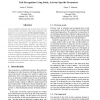Free Online Productivity Tools
i2Speak
i2Symbol
i2OCR
iTex2Img
iWeb2Print
iWeb2Shot
i2Type
iPdf2Split
iPdf2Merge
i2Bopomofo
i2Arabic
i2Style
i2Image
i2PDF
iLatex2Rtf
Sci2ools
CVPR
2001
IEEE
2001
IEEE
Gait Recognition Using Static, Activity-Specific Parameters
A gait-recognition technique that recovers static body and stride parameters of subjects as they walk is presented. This approach is an example of an activity-specific biometric: a method of extracting identifying properties of an individual or of an individual's behavior that is applicable only when a person is performing that specific action. To evaluate our parameters, we derive an expected confusion metric -- related to mutual information -- as opposed to reporting a percent correct with a limited database. This metric predicts how well a given feature vector will filter identity in a large population. We test the utility of a variety of body and stride parameters recovered in different viewing conditions on a database consisting of 15 to 20 subjects walking at both an angled and frontal-parallel view with respect to the camera, both indoors and out. We also analyze motioncapture data of the subjects to discover whether confusion in the parameters is inherently a physical or ...
Computer Vision | CVPR 2001 | Expected Confusion | Feature Vector | Percent Correct | Static Body | Visual Measurement Error |
| Added | 12 Oct 2009 |
| Updated | 12 Oct 2009 |
| Type | Conference |
| Year | 2001 |
| Where | CVPR |
| Authors | Aaron F. Bobick, Amos Y. Johnson |
Comments (0)

